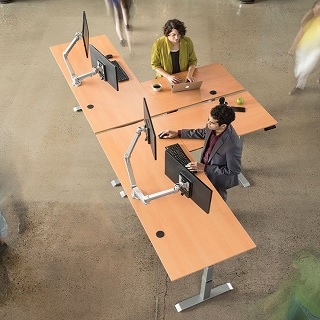Not all standing desk users have the same preferences. When looking for standing desks online each seller has their own curated selection of desktops that go along with their standing desk bases. The reason behind this is to offer all the customers what their standing desk should look like in their homes.
With so many desk toppers to look at, it is difficult which to choose which and not to mention the terminology in identifying the different tops. To guide the shoppers in all the terminology, how the desktop type is made, the pros and cons of each type, and the price range.
To keep it simple, there are two major categories, Laminated Desk Tops, and Solid Wood Desktops, which also contain several subcategories.
Laminated Desk Toppers
Lamination desk toppers are what it is, a laminated top. Lamination is the manufacturing technique of material in multiple layers. The finished table top is appealing and has strength and durability. Lamination can cover vinyl wraps and natural wood veneers to melamine or even metal.
Laminates bond to “substrates” which is usually a wood product by sticking with adhesives, pressure, and temperature. The same technique used by a laminated menu at a restaurant. The lamination gives rigidity, durability, and moisture protection to the product.
For the desktops used in standing desks, the substrate is a Medium Density Fiberboard, known as MDF. It is made by recycling scrap wood, grinding it down to the same sizes, adding a resin to bind everything together, and then pressing it under high temperature and pressure.
The great qualities of laminated desk toppers are that being much cheaper than a solid plank of natural wood and will last a long time.
The uniformity of the desk toppers makes it isotropic; it means that it has the same properties all over the top as a result of having no grain, and no knots. It can be easily be shaped and bond laminates.
MDF doesn’t contract and expand with temperature like natural wood once fully laminated. Depending on the grade of the MDF used and what material is laminated to it, it is stronger and more durable than others.
MDF cannot be stained like natural wood even when spilled because of its plastic surface. But if it is not properly sealed, it can be damaged to moisture. Desk toppers that have grommet holes with exposed MDF can be ruined even with one accidental spill of a coffee cup.
The exposed parts of MDF should use waterproof paints or 3D laminates to protect it from moisture damage, something to note when shopping for a laminated MDF desktop.
High-end ones will be hermetically sealed. Check the product warranty if they have the five-year clause. These are the better ones. Most desktops don’t have any warranty at all that’s why they’re so easily damaged.
The Nature of a Powder Coated Desk Top
The cheapest way to laminate a piece of MDF is by applying the powder coating method, which is spray-painting the wood. Powder-coated tops are very vulnerable to damage since they have no protection from scratches, dents, or cleaning chemicals.
Many standing desk buyers are disappointed to see the paint coming off their desktops from spilled drinks, or by using a strong cleaning chemical. Wiping off with a damp cloth is ideal in keeping the desktop paint pristine.
The higher-quality desktop has moisture protecting seal but provides the bare minimum of hardness to the MDF; they are still easily scratched and dented as compared to HPL and other top-quality materials.
Another disadvantage of powder coating is that it can only be used for solid colors. There is no maple, cherry, or mahogany in a powder coat finish, but it is very cheap.
High-Pressure Laminate (HPL)
HPL is the next method in desktop finishing and has been around for a long time. The majority of office furniture is made with HPL surfaces. This is made by bonding a laminate such as melamine to the top and bottom of a rectangular plank of MDF. Combined with high temperature to keep the adhesives tightly firm of the laminate to the substrate, this is known as Thermally Fused Laminate, or TFL.
The second process of the HPL desktop is gluing all four edges of the plank which is edge banding. It comes in many varieties, but it commonly uses color-matched PVC strips that are glued to the thin edges.
A disadvantage with edge banding is that it shows visible seams, which makes the topper look simple and cheap but the glue dries out eventually. It leaves strips of edge banding peeling off at the corners. If the seams are exposed to spillage, air, or liquid. It eventually deteriorates.
Other times, edge banding is a rubber strip wrapped completely around the topper with one seam in the center of the back edge. This allows for corners to be rounded to avoid injury when hit by the user.
In areas like medical offices, the exposed seams of glue can accumulate bacteria, and the glue is weakened by harsh cleaning chemicals. For standing desks, people tend to lean against the front edge of their HPL tops where they leave a reddish line in the forearm where they leaned against it.
The good thing about the HPL that it is very widely manufactured, especially in China and Europe, and is very affordable. It may not be the best desk topper but it is cheap. To find the best standing desk toppers, go to Flexispot.com
Conclusions:
Now we covered the laminated desk toppers with their pros and cons. In the next article, we will cover the wooden desk toppers and why it is the most preferred standing desktops.













